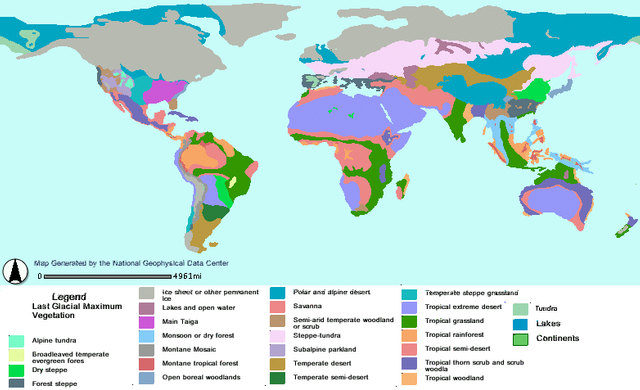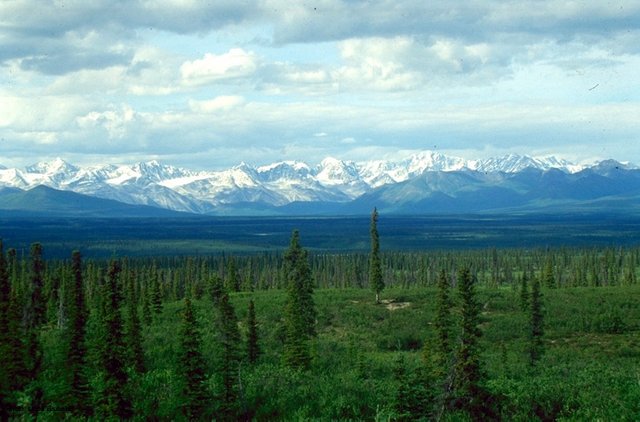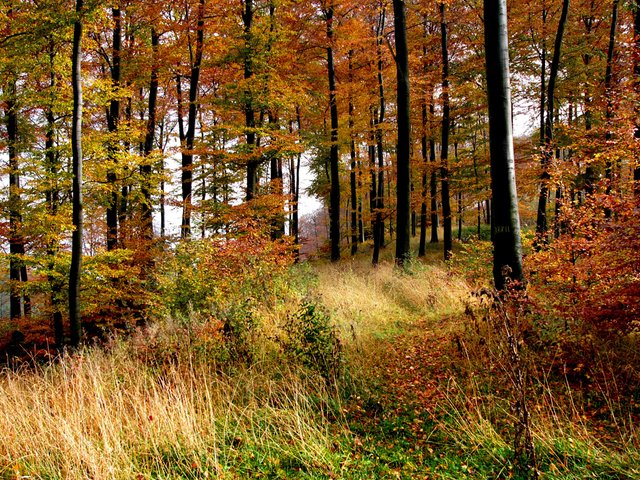Some Ecology Biomes.
Biome :

Image credits: See page for author [Public domain], via Wikimedia Commons
Biome is a geographical region that contains common climates, flora and fauna. The flora of an area are the plants. The fauna of an area is the animals. We're going to start off looking at terrestrial or land biomes. With terrestrial biomes, it only makes up about 25 percent of the Earth's surface. It's not very much. One of the major things that contributes or changes our terrestrial biomes is the climate. Remember, the climate is the temperature and moisture in an area. The climate will determine, what plants will grow and defines the land biome. The land biomes really are all about the climate that's there. Climate will change with latitude, the distance north or south of the Equator, and with altitude, the height above the Earth's surface or the height above sea level. So, those two things latitude and altitude can change your climate. If you remember from Earth Science, when you talked about the globe or when you talked about the earth, if you start at 0 degrees or if you start at the equator, it's warm and wet. If you go 30 degrees north or south it's warm or dry. Another 30 degrees and you get cold and wet. And then finally that lasts 30 degrees, so you're at the poles. You're at cold and dry. Now, based on that temperature and moisture that's going to determine the climate of that area. So, the first one that we're going to look at is what we call the tundra.
Tundra :

Image By U.S. Fish and Wildlife Service [Public domain], via Wikimedia Commons
The tundra is cold and dry. So basically, we're all the way up toward the top, almost to 90 degrees north. It's less than 10 inches of precipitation annually, not much rain or water. Has a very short summer with a calm day light. The Sun never goes down. It's always there spinning over your head. In the tundra, the soil contains something called permafrost. With permafrost, that means that the ground is completely frozen about a meter below the surface. So, if you dig down at one meter you're gonna hit solid ground. You're gonna hit frozen ground. You can't dig into that. Usually, at other places in the spring and the fall that melts and our ground isn't frozen. We can dig wells. We can build houses. If you're in the tundra, that ground stays frozen and you can only get down about 3 feet. Vegetation is mosses, lichens and grasses things that don't require a lot of water. Since there isn't water there and many of the animals are there in the summer but not in the winter as you could probably imagine it's not the most pleasant place in the wintertime. So, if they're there in the summer what are they? they're usually migratory animals like birds. So they come in, they hang out for the summer but then they go back away again. That takes us down to what we call the taiga.
Taiga :

Image By L.B. Brubaker (NOAA photo [1]) [Public domain], via Wikimedia Commons
The taiga is the evergreen forest. Generally speaking, with the taiga, it's got lichens and mosses on the floor it is warmer and wetter than the tundra. It's got a five to seven month winter. The soil is mostly needles. Needles don't break down. They don't decompose very well. So the soil isn't super rich. It's difficult for things to grow in the taiga but these evergreen trees have adapted to that and they grow very well actually. There's a nickname for the Taiga which is the spruce moose biome. That's because the spruce is the dominant plant. The Moose is the dominant animal. So it's kind of picked up this nickname as time has gone on. Even though it says five to seven month winter Taiga is not there. You need to go further north more up into Canada. That's when you fall actually into the taiga. So, what do we fall under? we fall under what they call the temperate deciduous forest.
The temperate deciduous forest :

Image By Nikater (Own work) [Public domain], via Wikimedia Commons
The temperate deciduous forest has broad leaf deciduous trees. New York State is a temperate deciduous forest. It's a five to eight month growing season. So, instead of saying a five to seven month winter, things change up a little bit it's a five to eight month growing season and we have pretty fertile soil which they didn't have in the taiga. We're able to grow many more things whether it's a farm or just your yard. Whatever it happens to be we can grow a lot more in the temperate deciduous forests because the soil is so much more fertile or capable of allowing things to grow in it.
References :
Quality post. I enjoy stumbling on posts like this where I end up reading the whole thing and learning something. Good stuff!
@pratiquw007 Thanks for offering something to learn. Things like thgis help make Steemit become #1!
I see your doing good with minnowsupport promotion, try using this too,
Use my referral link to this boosting community, which will help you get noticed faster.
https://steemfollower.com/?r=13941
Its a free community to help boost upvotes daily on your most recent post,
Enjoy! Come visit my page for more help posts.
Congratulations! This post has been upvoted from the communal account, @minnowsupport, by pratique007 from the Minnow Support Project. It's a witness project run by aggroed, ausbitbank, teamsteem, theprophet0, someguy123, neoxian, followbtcnews, and netuoso. The goal is to help Steemit grow by supporting Minnows. Please find us at the Peace, Abundance, and Liberty Network (PALnet) Discord Channel. It's a completely public and open space to all members of the Steemit community who voluntarily choose to be there.
If you would like to delegate to the Minnow Support Project you can do so by clicking on the following links: 50SP, 100SP, 250SP, 500SP, 1000SP, 5000SP.
Be sure to leave at least 50SP undelegated on your account.